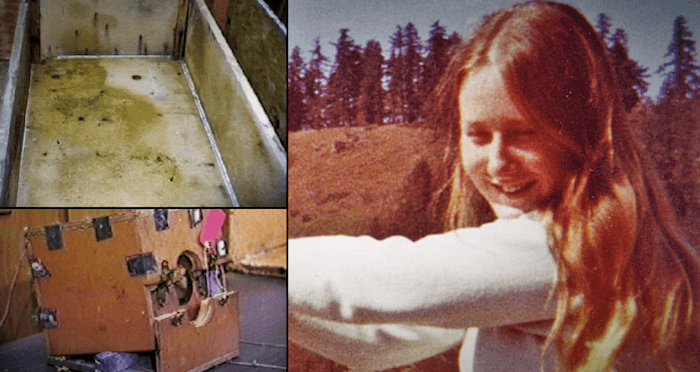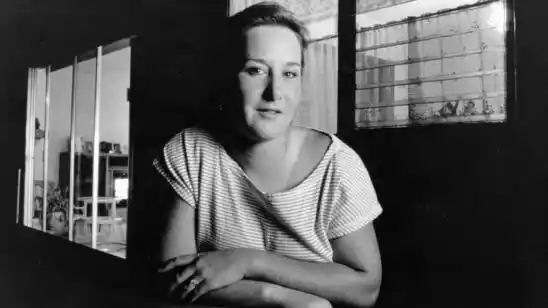In the late 1970s, the seemingly ordinary life of a young woman named Colleen Stan took a dark and tragic turn. At the age of 20, Colleen was kidnapped by Cameron Hooker, a man whose sadistic tendencies and manipulative tactics would subject her to over seven years of unimaginable torture and control. Known to the world as “The Girl in the Box,” This story is a powerful testament to human resilience and the will to survive against all odds.
Discover the chilling true story of the Kidnapping of Colleen Stan, famously known as ‘The Girl in the Box,’ and her harrowing experience of kidnapping and survival.
Table of Contents
Colleen Stan: A Brief Background

Colleen Stan was born on December 31, 1956, in Riverside, California. By 1977, she was living in Eugene, Oregon, and had embarked on a journey to visit friends in Northern California. Little did she know, this seemingly routine trip would alter the course of her life forever.

The Fateful Hitchhiker
On May 19, 1977, Colleen decided to hitchhike from her home in Eugene to a friend’s house in Northern California. Although she was cautious and usually careful about whom she accepted rides from, she believed she was safe when Cameron Hooker, his wife Janice, and their baby offered her a ride. Unfortunately, this decision would lead to her capture and years of torment.
Cameron Hooker: The Captor
Cameron Hooker, a lumber mill worker, appeared to be an ordinary man but harbored deeply sadistic desires. Hooker had a history of violent sexual fantasies and had convinced his wife, Janice, to participate in his twisted plans. The couple had already kidnapped and abused another woman before setting their sights on Colleen.
The Abduction
Once Colleen was in the car, the Hookers drove to an isolated area where Cameron threatened her with a knife, bound her hands, and forced a homemade wooden box over her head. This box would become a recurring element in her captivity, symbolizing the severe psychological and physical abuse she would endure.
Life in Captivity
For the next seven years, Colleen lived in a state of constant fear and suffering. Cameron Hooker kept her confined in a coffin-like box for up to 23 hours a day, allowing her out only for physical and sexual abuse. The box was designed to limit her movement and sensory input, creating a form of psychological torture that would break her spirit.
The Role of Janice Hooker

Janice Hooker’s role in Colleen’s captivity is complex and controversial. Initially, Janice was a participant in the abuse, having been manipulated and coerced by her husband. Over time, however, she became increasingly conflicted and eventually played a crucial role in Colleen’s escape. Janice’s complicity and eventual cooperation with authorities raise essential questions about coercion and victimization.
Psychological Manipulation and Control
Cameron Hooker’s control over Colleen extended beyond physical abuse. He manipulated her psychologically, convincing her that an all-powerful organization called “The Company” would harm her and her family if she attempted to escape. This fictional narrative created a pervasive fear and hopelessness that kept Colleen compliant and submissive.
Colleen’s Daily Life
Colleen’s daily life was marked by routine tasks and strict rules imposed by Hooker. She was forced to perform household chores, endure regular physical abuse, and remain silent about her captivity. Despite the unimaginable conditions, Colleen found ways to mentally cope, drawing on her faith and inner strength to survive.
The Turning Point: Janice’s Confession
After years of captivity, a significant turning point occurred when Janice Hooker began to question her husband’s actions and her role in the abuse. In August 1984, Janice confessed to Colleen that “The Company” was a fabrication and that she could safely leave. This revelation shattered the psychological chains that had bound Colleen for so long.
Colleen’s Escape
On August 10, 1984, after more than seven years of captivity, Colleen Stan escaped. Janice drove her to a bus station, where Colleen called her family for the first time in years. Her escape marked the end of a horrific chapter and the beginning of a long journey toward healing and justice.
Legal Proceedings and Justice

Following her escape, Colleen Stan bravely participated in the legal proceedings against Cameron Hooker. In 1985, Hooker was arrested and charged with kidnapping, rape, and sexual assault. During the trial, Colleen’s testimony was crucial in securing a conviction. Cameron Hooker was sentenced to 104 years in prison, ensuring he could no longer harm others.
Life After Captivity
Rebuilding her life after years of trauma was a monumental task for Colleen Stan. She faced numerous challenges, including psychological scars and the difficulty of reintegrating into society. Despite these obstacles, Colleen demonstrated remarkable resilience, drawing on support from her family and therapy to heal and move forward.
The Impact on Society and the Legal System
The case of Colleen Stan had a profound impact on society and the legal system. It brought attention to the severity of psychological manipulation and control in cases of prolonged captivity. The story highlighted the need for better support systems for survivors and more comprehensive measures to prevent such crimes.
Cameron Hooker Parole Hearing: The Fight for Justice
Cameron Hooker’s parole hearing, delayed to December 17, has sparked public outrage. Convicted for the abduction and torture of Colleen Stan, Hooker’s release remains opposed by prosecutors and victim advocates. To learn more about the ongoing legal battle, read the article Cameron Hooker Hearing Delayed.
Survival and Resilience: Colleen Stan’s Legacy
Colleen Stan’s story is not just one of victimization but also survival and resilience. Her ability to endure years of unimaginable suffering and emerge with a desire to help others is a powerful testament to the human spirit. Colleen’s legacy continues to inspire and educate, reminding us of the strength within us all.
Psychological Aftermath and Healing
The psychological aftermath of Colleen’s ordeal was profound. She experienced symptoms of post-traumatic stress disorder (PTSD), anxiety, and depression. Her healing process involved extensive therapy, support from loved ones, and a commitment to reclaiming her life. Colleen’s journey underscores the importance of mental health care for survivors of extreme trauma.
Public Perception and Media Coverage
The kidnapping of Colleen Stan received extensive media coverage, captivating the public’s attention. Her story was featured in numerous documentaries, books, and articles, each detailing the horrific nature of her captivity and her extraordinary survival. The media’s portrayal of Colleen’s ordeal played a significant role in raising awareness about the realities of kidnapping and abuse.
The Role of Law Enforcement
Law enforcement played a critical role in Colleen’s case, from her initial rescue to the prosecution of Cameron Hooker. The investigation required meticulous evidence gathering and sensitive handling of Colleen’s testimony. The dedication of law enforcement professionals was instrumental in bringing justice to Colleen and preventing future crimes.
Support Systems for Survivors
The story of Colleen Stan highlights the importance of robust support systems for survivors of trauma. Organizations providing legal, psychological, and social support are vital in helping individuals rebuild their lives after experiencing severe abuse. Colleen’s case underscores the need for continued investment in these resources.
Colleen Stan’s Advocacy Work

In the years following her escape, Colleen Stan has become an advocate for victims of kidnapping and abuse. She has shared her story to raise awareness and educate others about the signs of abuse and the importance of speaking out. Her advocacy work has had a lasting impact, contributing to a greater understanding of the complexities of trauma and recovery.
Lessons Learned from Colleen’s Story
Colleen Stan’s ordeal offers several important lessons. It emphasizes the importance of vigilance and caution in everyday interactions, the power of psychological manipulation, and the resilience of the human spirit. Her story also highlights the necessity of comprehensive legal and support frameworks to protect and aid victims.
Similar ” Kidnapping”
- Ariel Castro Kidnappings: Inside the Cleveland Abductions
- Jonelle Matthews: The Cold Case That Shocked America
- Was Rainn Peterson Kidnapped?
- Medical Kidnapping – A Hidden Crisis in Healthcare
The Continuing Fight Against Kidnapping and Abuse
Despite progress in awareness and prevention, kidnapping and abuse remain significant issues worldwide. Colleen Stan’s story serves as a reminder of the ongoing need for vigilance, education, and advocacy. Efforts to combat these crimes must continue to evolve, incorporating lessons learned from past cases to protect vulnerable individuals better.
Read “Colleen Stan: The Simple Gifts of Life: Dubbed by the Media “The Girl in the Box” and “The Sex Slave””

During my years-long confinement, the uncertainty of my fate and the constant fear kept me under my captor’s control. The lack of knowledge, while terrifying, may have been a blessing, as knowing the duration of my imprisonment might have broken me. This isolation was likely a response to concerns about my visibility and potential questions from outsiders, as well as a way to appease my captor’s wife, who wanted me out of their lives. My days became a predictable routine of evening releases for basic needs, after which I would return to my hidden prison.
Conclusion
The kidnapping of Colleen Stan, “The Girl in the Box,” is a harrowing tale of human cruelty and resilience. Her story of survival against all odds is a powerful reminder of the strength and determination within us all. Through her journey, Colleen has become a symbol of hope and a beacon for others who have endured similar horrors. Reflecting on her ordeal, we are reminded of the importance of compassion, support, and justice in creating a safer world for everyone.
FAQs
What role did Janice Hooker play in Colleen’s captivity?
Janice Hooker was initially complicit in Colleen’s captivity due to manipulation and coercion by her husband. However, she later played a crucial role in helping Colleen escape and testified against Cameron Hooker.
How did Colleen Stan cope with her captivity?
Colleen Stan coped with her captivity by drawing on her inner strength, faith, and hope. She also developed survival strategies to mentally and emotionally endure the abuse.
What impact did Colleen Stan’s case have on society?
Colleen Stan’s case brought significant attention to the issues of psychological manipulation and control in prolonged captivity. It highlighted the need for better support systems for survivors and influenced legal and social frameworks to prevent such crimes.
Where is Colleen Stan now?
As of recent updates, Colleen Stan continues to live a private life, focusing on her recovery and advocacy work to support other victims of kidnapping and abuse.